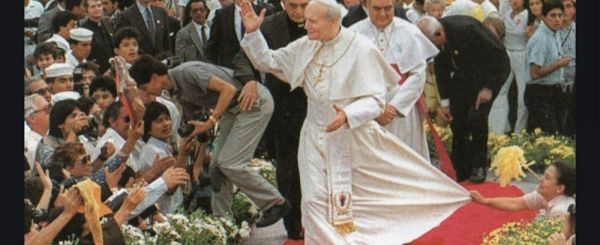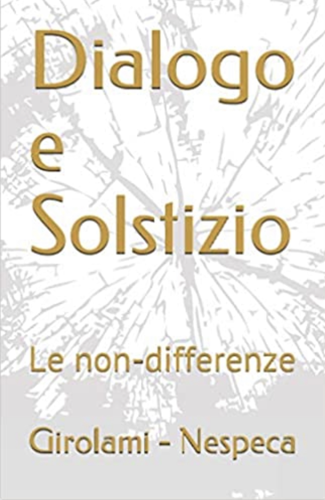2. Forgiveness! Christ taught us to forgive. He spoke of forgiveness many times and in various ways. When Peter asked him how many times he should forgive his neighbour, "up to seven times?", Jesus replied that he should forgive "up to seventy times seven" (Mt 18:21f). This means, in practice, always: in fact, the number "seventy" for "seven" is symbolic and means, rather than a specific quantity, an incalculable, infinite quantity. Responding to the question of how we should pray, Christ uttered those magnificent words addressed to the Father: "Our Father who art in heaven"; and among the requests that make up this prayer, the last one speaks of forgiveness: "Forgive us our trespasses as we forgive those who trespass against us" (= "our debtors"). Finally, Christ himself confirmed the truth of these words on the Cross when, turning to the Father, he pleaded: "Forgive them!", "Father, forgive them, for they know not what they do" (Lk 23:34).
"Forgiveness" is a word spoken by the lips of a man who has been wronged. Indeed, it is the word of the human heart. In this word of the heart, each of us strives to overcome the barrier of enmity that can separate us from others, seeking to rebuild the inner space of understanding, contact and bond. Christ taught us with the words of the Gospel, and above all with his own example, that this space opens up not only before other people, but at the same time before God himself. The Father, who is a God of forgiveness and mercy, desires to act precisely in this space of human forgiveness. He desires to forgive those who are capable of forgiving one another, those who seek to put into practice those words: "Forgive us... as we forgive".
Forgiveness is a grace that must be considered with deep humility and gratitude. It is a mystery of the human heart that is difficult to explain.
5. Christ taught us to forgive. Forgiveness is also indispensable so that God can pose questions to the human conscience, questions to which He awaits an answer in all inner truth.
In this time, when so many innocent people are dying at the hands of other people, there seems to be a special need to approach each of those who kill, to approach them with forgiveness in our hearts and with the same question that God, Creator and Lord of human life, asked of the first man who had attempted to take the life of his brother and had taken it from him — had taken what belongs only to the Creator and Lord of life.
Christ taught us to forgive. He taught Peter to forgive 'seventy times seven times' (Mt 18:22). God himself forgives when man responds to the question addressed to his conscience and to his heart with all the inner truth of conversion.
Leaving to God himself the judgement and sentence in its definitive dimension, we do not cease to ask: "Forgive us our debts as we forgive our debtors".
[Pope John Paul II, General Audience, 21 October 1981]
Space opening up before us

don Giuseppe Nespeca
Giuseppe Nespeca è architetto e sacerdote. Cultore della Sacra scrittura è autore della raccolta "Due Fuochi due Vie - Religione e Fede, Vangeli e Tao"; coautore del libro "Dialogo e Solstizio".
Email This email address is being protected from spambots. You need JavaScript enabled to view it.In the divine attitude justice is pervaded with mercy, whereas the human attitude is limited to justice. Jesus exhorts us to open ourselves with courage to the strength of forgiveness, because in life not everything can be resolved with justice. We know this (Pope Francis)
Nell’atteggiamento divino la giustizia è pervasa dalla misericordia, mentre l’atteggiamento umano si limita alla giustizia. Gesù ci esorta ad aprirci con coraggio alla forza del perdono, perché nella vita non tutto si risolve con la giustizia; lo sappiamo (Papa Francesco)
The Second Vatican Council's Constitution on the Sacred Liturgy refers precisely to this Gospel passage to indicate one of the ways that Christ is present: "He is present when the Church prays and sings, for he has promised "where two or three are gathered together in my name there am I in the midst of them' (Mt 18: 20)" [Sacrosanctum Concilium, n. 7]
La Costituzione sulla Sacra Liturgia del Concilio Vaticano II si riferisce proprio a questo passo del Vangelo per indicare uno dei modi della presenza di Cristo: "Quando la Chiesa prega e canta i Salmi, è presente Lui che ha promesso: "Dove sono due o tre riuniti nel mio nome, io sono in mezzo a loro" (Mt 18, 20)" [Sacrosanctum Concilium, 7]
This was well known to the primitive Christian community, which considered itself "alien" here below and called its populated nucleuses in the cities "parishes", which means, precisely, colonies of foreigners [in Greek, pároikoi] (cf. I Pt 2: 11). In this way, the first Christians expressed the most important characteristic of the Church, which is precisely the tension of living in this life in light of Heaven (Pope Benedict)
Era ben consapevole di ciò la primitiva comunità cristiana che si considerava quaggiù "forestiera" e chiamava i suoi nuclei residenti nelle città "parrocchie", che significa appunto colonie di stranieri [in greco pàroikoi] (cfr 1Pt 2, 11). In questo modo i primi cristiani esprimevano la caratteristica più importante della Chiesa, che è appunto la tensione verso il cielo (Papa Benedetto)
A few days before her deportation, the woman religious had dismissed the question about a possible rescue: “Do not do it! Why should I be spared? Is it not right that I should gain no advantage from my Baptism? If I cannot share the lot of my brothers and sisters, my life, in a certain sense, is destroyed” (Pope John Paul II)
Pochi giorni prima della sua deportazione la religiosa, a chi le offriva di fare qualcosa per salvarle la vita, aveva risposto: "Non lo fate! Perché io dovrei essere esclusa? La giustizia non sta forse nel fatto che io non tragga vantaggio dal mio battesimo? Se non posso condividere la sorte dei miei fratelli e sorelle, la mia vita è in un certo senso distrutta" (Papa Giovanni Paolo II)
By willingly accepting death, Jesus carries the cross of all human beings and becomes a source of salvation for the whole of humanity. St Cyril of Jerusalem commented: “The glory of the Cross led those who were blind through ignorance into light, loosed all who were held fast by sin and brought redemption to the whole world of mankind” (Catechesis Illuminandorum XIII, 1: de Christo crucifixo et sepulto: PG 33, 772 B) [Pope Benedict]
Accettando volontariamente la morte, Gesù porta la croce di tutti gli uomini e diventa fonte di salvezza per tutta l’umanità. San Cirillo di Gerusalemme commenta: «La croce vittoriosa ha illuminato chi era accecato dall’ignoranza, ha liberato chi era prigioniero del peccato, ha portato la redenzione all’intera umanità» (Catechesis Illuminandorum XIII,1: de Christo crucifixo et sepulto: PG 33, 772 B) [Papa Benedetto]
duevie.art
don Giuseppe Nespeca
Tel. 333-1329741
Disclaimer
Questo blog non rappresenta una testata giornalistica in quanto viene aggiornato senza alcuna periodicità. Non può pertanto considerarsi un prodotto editoriale ai sensi della legge N°62 del 07/03/2001.
Le immagini sono tratte da internet, ma se il loro uso violasse diritti d'autore, lo si comunichi all'autore del blog che provvederà alla loro pronta rimozione.
L'autore dichiara di non essere responsabile dei commenti lasciati nei post. Eventuali commenti dei lettori, lesivi dell'immagine o dell'onorabilità di persone terze, il cui contenuto fosse ritenuto non idoneo alla pubblicazione verranno insindacabilmente rimossi.











